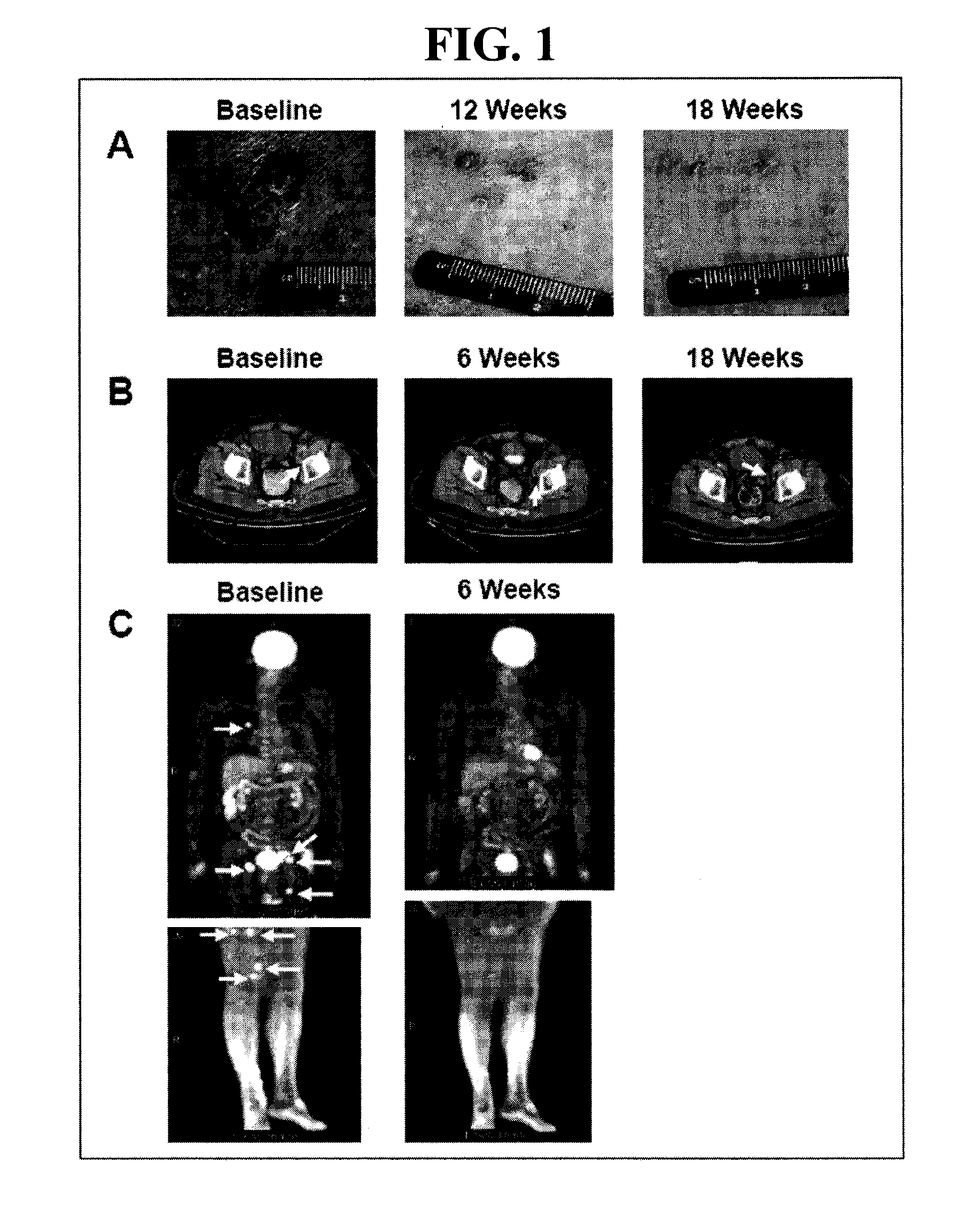c-KIT Phosphorylation in Cancer
a cancer and phosphorylation technology, applied in the field of cancer diagnosis, treatment and monitoring, can solve the problems of not being well characterized in other human cancers, unable and clinical research has not been able to identify a correlation between c-kit mutation, splice variant or truncation, and metastatic melanoma
- Summary
- Abstract
- Description
- Claims
- Application Information
AI Technical Summary
Benefits of technology
Problems solved by technology
Method used
Image
Examples
example 1
Clinical Analysis of Imatinib Treatment
[0037]Melanomas express the major targets of imatinib such as c-KIT and PDGFRs and are considered to be a suitable disease for imatinib treatment. Unfortunately, results obtained from the clinical trials have been disappointing (Wyman, 2006; Eton, 2004). One Phase II trial with high dose imatinib (800 mg / day) involving 26 patients from Vanderbilt-Ingram Cancer Center and Beth Israel Deaconess Medical Center showed significant toxicity but failed to show any clinical response (Wyman, 2006). Low levels of c-KIT and other imatinib targets were observed in these tumors, and that may explain in part a lack of clinical response in these patients.
[0038]In a second Phase II trial conducted at M. D. Anderson Cancer Center, 21 patients with stage III (10%) and IV (90%) melanoma were enrolled. All had tumors expressing at least one target PTK, i.e., c-KIT, PDGFRα, or PDGFRβ. These patients received a total of 33 courses of imatinib (median, one course per...
example 2
Mechanism for Imatinib Responsiveness in Melanoma
[0040]The mechanism of Y721 hyperphosphorylation in the imatinib responder provides a method to develop novel treatments and monitor disease remission. Although it is known that both Y703 and Y721 are autophosphorylated by c-KIT kinase upon SCF stimulation (Duensing, 2004), the preferential phosphorylation of Y721 in the responder suggests a novel mechanism of c-KIT activation. To elucidate the mechanism, we use (1) RT-PCR and LSC analysis to examine the existence of aberrant c-KIT mRNAs and proteins; and (2) in vitro assays to examine the function of c-KIT mutant. Identification of a novel mechanism for c-KIT activation in tumors provides additional markers to predict responsiveness to imatinib in melanoma patients as well as patients with other types of cancer.
[0041]Phosphorylation status of imatinib targets, i.e., c-KIT, PDGFRα, and PDGFRβ were monitored. For c-KIT phosphorylation, tumor biopsies obtained at baseline (pre-treatment...
example 3
Correlation of c-KIT Phosphorylation and Imatinib Responsiveness
[0056]In the previous study, we found one melanoma patient (n=40) with a dramatic near-complete response to imatinib treatment for more than a year. The most correlative marker for imatinib response is the hyperphosphorylation of c-KIT at Y721 in the responder at baseline. In addition, among this cohort, this patient is the only one with acral lentiginous melanoma. The goal of this aim is to validate the correlation between c-KIT hyperphosphorylation at Y703 or Y721 and patients with acral lentiginous melanoma. We hypothesize that patients with acral lentiginous melanoma have hyperphosphorylated c-KIT. To test this hypothesis, we will determine the phosphorylation status of c-KIT in the tumor biopsies obtained from acral lentiginous melanoma patients (n=5) using LSC. In addition, the expression of PK and / or PTP genes identified in Aim 1 will be likewise analyzed in these tumor biopsies. A successful demonstration of c-K...
PUM
| Property | Measurement | Unit |
|---|---|---|
| Fraction | aaaaa | aaaaa |
| Fraction | aaaaa | aaaaa |
| Inhibition | aaaaa | aaaaa |
Abstract
Description
Claims
Application Information
 Login to View More
Login to View More - R&D
- Intellectual Property
- Life Sciences
- Materials
- Tech Scout
- Unparalleled Data Quality
- Higher Quality Content
- 60% Fewer Hallucinations
Browse by: Latest US Patents, China's latest patents, Technical Efficacy Thesaurus, Application Domain, Technology Topic, Popular Technical Reports.
© 2025 PatSnap. All rights reserved.Legal|Privacy policy|Modern Slavery Act Transparency Statement|Sitemap|About US| Contact US: help@patsnap.com



